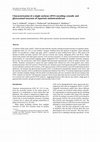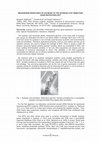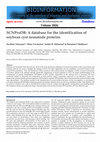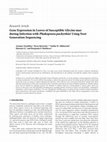Papers by Benjamin Matthews
Legume Crop Genomics, 2004
AFRICAN JOURNAL OF BIOTECHNOLOGY, 2012

Plant Molecular Biology, Jun 1, 1998
A soybean cDNA clone, pSAT1, which encodes both the cytosolic and glyoxysomal isozymes of asparta... more A soybean cDNA clone, pSAT1, which encodes both the cytosolic and glyoxysomal isozymes of aspartate aminotransferase (AAT; EC 2.6.1.1) was isolated. Genomic Southern blots and analysis of genomic clones indicated pSAT1 was encoded by a single copy gene. pSAT1 contained an open reading frame with ca. 90% amino acid identity to alfalfa and lupin cytosolic AAT and two in-frame start codons, designated ATG1 and ATG2. Alignment of this protein with other plant cytosolic AAT isozymes revealed a 37 amino acid N-terminal extension with characteristics of a peroxisomal targeting signal, designated PTS2, including the modified consensus sequence RL-X 5 -HF. The second start codon ATG2 aligned with previously reported start codons for plant cytosolic AAT cDNAs. Plasmids constructed to express the open reading frame initiated by each of the putative start codons produced proteins with AAT activity in Escherichia coli. Immune serum raised against the pSAT1-encoded protein reacted with three soybean AAT isozymes, AAT1 (glyoxysomal), AAT2 (cytosolic), and AAT3 (subcellular location unknown). We propose the glyoxysomal isozyme AAT1 is produced by translational initiation from ATG1 and the cytosolic isozyme AAT2 is produced by translational initiation from ATG2. N-terminal sequencing of purified AAT1 revealed complete identity with the pSAT1-encoded protein and was consistent with the processing of the PTS2. Analysis of cytosolic AAT genomic sequences from several other plant species revealed conservation of the two in-frame start codons and the PTS2 sequence, suggesting that these other species may utilize a single gene to generate both cytosolic and glyoxysomal or peroxisomal forms of AAT.
J Biol Chem, 2006
ABSTRACT

Planta, 2007
Our laboratory has been working toward increasing our understanding of the genetic control of col... more Our laboratory has been working toward increasing our understanding of the genetic control of cold hardiness in blueberry (Vaccinium section Cyanococcus) to ultimately use this information to develop more cold hardy cultivars for the industry. Here, we report using cDNA microarrays to monitor changes in gene expression at multiple times during cold acclimation under Weld and cold room conditions. Microarrays contained over 2,500 cDNA inserts, approximately half of which had been picked and single-pass sequenced from each of two cDNA libraries that were constructed from cold acclimated Xoral buds and non-acclimated Xoral buds of the fairly cold hardy cv. Bluecrop (Vaccinium corymbosum L.). Two biological samples were examined at each time point. Microarray data were analyzed statistically using t tests, ANOVA, clustering algorithms, and online analytical processing (OLAP). Interestingly, more transcripts were found to be upregulated under cold room conditions than under Weld conditions. Many of the genes induced only under cold room conditions could be divided into three major types: (1) genes associated with stress tolerance; (2) those that encode glycolytic and TCA cycle enzymes, and (3) those associated with protein synthesis machinery. A few of the genes induced only under Weld conditions appear to be related to light stress. Possible explanations for these diVerences are discussed in physiological context. Although many similarities exist in how plants respond during cold acclimation in the cold room and in the Weld environment, there are major diVerences suggesting caution should be taken in interpreting results based only on artiWcial, cold room conditions.
Gene regulation and systems biology

Journal of nematology
Protease inhibitors play a role in regulating proteases during cellular development and in plant ... more Protease inhibitors play a role in regulating proteases during cellular development and in plant defense. We cloned and sequenced cDNA encoding six protease inhibitors expressed in soybean roots infected with soybean cyst nematode (SCN) and determined their expression patterns. Four of these protease inhibitors are novel and have not been reported previously. Using RT-PCR, we measured the relative transcript levels of each protease inhibitor in roots of the soybean cv. Peking inoculated with either SCN TN8 to examine the expression of protease inhibitors during the susceptible interaction or with SCN NL1-RHg representing the resistant interaction. Within 12 to 24 hours, mRNA transcripts encoding five of the six protease inhibitors were more highly elevated in soybean roots exhibiting the susceptible interaction than the resistant interaction. Transcripts encoding two protease inhibitors possessing Kunitz trypsin inhibitor domains were induced 37-and 27-fold in the susceptible interaction within 1 dpi, but were induced only 5-to 7-fold in roots displaying the resistant interaction. Our results indicate that soybean roots recognize differences between these two SCN populations before the nematodes initiate a feeding site, and accordingly the roots express transcripts encoding soybean protease inhibitors differentially. These transcripts were generally less abundant in roots exhibiting the resistant interaction.

The soybean cyst nematode (SCN), Heterodera glycines, is the major pest of soybean and causes an ... more The soybean cyst nematode (SCN), Heterodera glycines, is the major pest of soybean and causes an estimated one-half to one billion dollars in damage each year in the US. Chemical control for soybean is not normally used because economic and environmental costs are prohibitive. Therefore, agricultural practices, such as crop rotation and the use of resistant cultivars, are used to mitigate the damage of SCN. There is usually a trade off between using the highest yielding soybean varieties, which are susceptible to SCN, and lower yielding SCN-resistant varieties. In the soil, SCN populations are diverse and are composed of numerous phenotypes or races. This variability in the SCN population complicates the effective use of cultivars resistant to SCN by farmers to control SCN in the soil and confounds rotation schemes. My research goal is to engineer transgenic soybean using multiple approaches to provide the farmer with high yielding soybean varieties with broad, durable resistance to...

Bioinformation, 2014
Soybean cyst nematode (Heterodera glycines, SCN) is the most destructive pathogen of soybean arou... more Soybean cyst nematode (Heterodera glycines, SCN) is the most destructive pathogen of soybean around the world. Crop rotation and resistant cultivars are used to mitigate the damage of SCN, but these approaches are not completely successful because of the varied SCN populations. Thus, the limitations of these practices with soybean dictate investigation of other avenues of protection of soybean against SCN, perhaps through genetically engineering of broad resistance to SCN. For better understanding of the consequences of genetic manipulation, elucidation of SCN protein composition at the subunit level is necessary. We have conducted studies to determine the composition of SCN proteins using a proteomics approach in our laboratory using twodimensional polyacrylamide gel electrophoresis (2D-PAGE) to separate SCN proteins and to characterize the proteins further using mass spectrometry. Our analysis resulted in the identification of several hundred proteins. In this investigation, we de...
Recent Advances in Phytochemistry, 2001
... Chapter Two MICROARRAYS: APPLICATION TO SOYBEAN GENE EXPRESSION DURING SOYBEAN CYST NEMATODE ... more ... Chapter Two MICROARRAYS: APPLICATION TO SOYBEAN GENE EXPRESSION DURING SOYBEAN CYST NEMATODE INVASION Benjamin F. Matthews USDA-ARS ... Co., 2000, 205 p. 3. HEGDE, P., QI, R., ABERNATHY, K., GAY, C., DHARAP, S., GASPARD, R., HUGHES ...
Plant Science Letters, 1983

Sequencing, 2011
Soybean rust is caused by the obligate biotrophic fungus Phakopsora pachyrhizi, an exotic pathoge... more Soybean rust is caused by the obligate biotrophic fungus Phakopsora pachyrhizi, an exotic pathogen causing important yield losses in soybean production. We used an mRNA-Seq strategy to analyze the expression pattern of soybean genes and better understand molecular events occurring in soybean following the infection. cDNA libraries were constructed from RNA isolated from whole infected soybean leaves 10 days after inoculation with P. pachyrhizi and sequenced using an Illumina platform to identify soybean genes that are affected by pathogen growth. We obtained 15 million sequences corresponding to soybean genes. Forty-two percent of the genes were downregulated including genes encoding proteins involved in amino acid metabolism, carbohydrate metabolism, and transport facilitation; 31% were upregulated including genes encoding proteins involved in lipid metabolism, glycan biosynthesis, and signal transduction. Candidate host genes identified in this study will be manipulated to assay their potential to control soybean rust disease.










Uploads
Papers by Benjamin Matthews